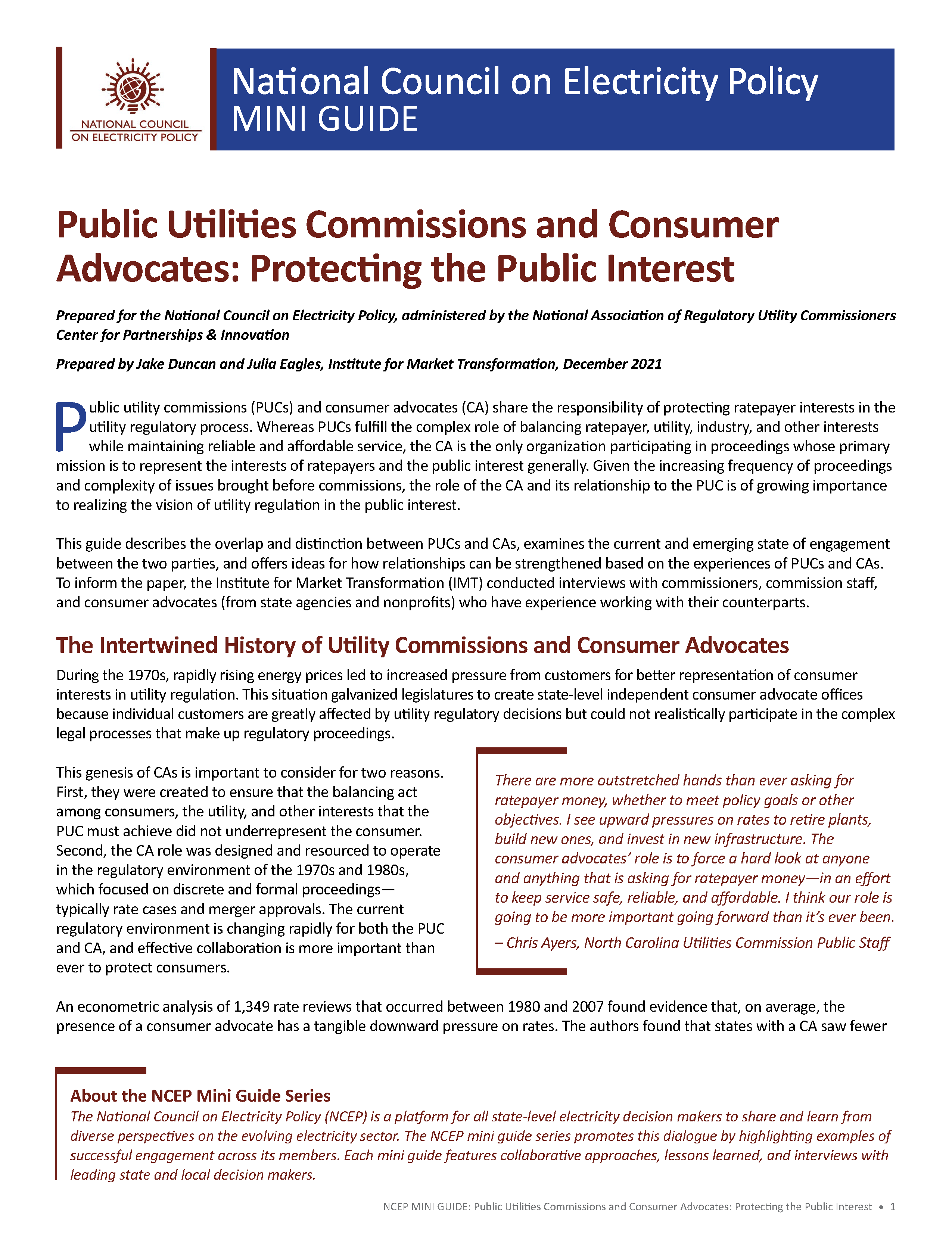Embedding Equity and Climate Considerations into Minnesota Utility’s Resource Planning Process
An equitable transition to clean power requires utilities to prioritize input from community stakeholders. Too often, frontline communities and advocates are dissuaded from participating in critical decisions by virtue of the opaque, technical process. With coordinated assistance and capacity-building support from local organizations, there are opportunities for stakeholders to intervene and demand private companies incorporate community feedback.
One of the key ways to advocate for decarbonization and social equity in the power sector is through utility integrated resource plans (IRPs). An IRP is a tool that regulated electric utilities use to develop a publicly available plan outlining the best way to meet consumer needs over time, usually over the coming 10 to 20 years. IRPs should consider a full range of feasible options on the supply side (utility-scale generation), demand side (customer-sited solutions), and distribution side (customer and community resources) and assess them against a common set of planning objectives and criteria. The goal is to identify the portfolio of resources that performs best against those objectives and criteria over the long-term, such as meeting policy requirements and maintaining reasonable rates.
Input from stakeholders such as consumer advocates, local governments, and environmental justice advocates is crucial in developing an IRP. Regulatory commissions will base their acceptance or rejection of a utility IRP on the evidence and testimony that intervenors submit to the official record. Utilities control the data assumptions they present, the resources they do and do not evaluate, and the scenarios they do and do not analyze. Without broad participation of stakeholders offering informative perspectives, a utility might not equitably consider all resource options, particularly those that may not support its management and financial goals.
Increasing Participation in Xcel Energy’s IRP
IMT recently concluded a successful effort to increase community participation in an IRP process for Xcel Energy – the largest electric and gas utility in Minnesota. Xcel Energy filed their original 2020-2034 IRP back in July of 2019, but this version did not sufficiently address community goals for energy affordability and sustainability. For example, the plan proposed to retire all of the utility’s coal plants in the state by 2030, but originally proposed replacing some of that generating capacity with natural gas. Many of the intervening parties raised concerns that this was counter to both state and local climate goals, as well as the utility’s own carbon reduction commitment.
For the past two years, IMT has provided technical assistance through the Bloomberg American Cities Climate Challenge to the City of Minneapolis, a coalition of nearly 40 local governments in Xcel Energy’s Minnesota service territory, and a group of community-based organizations (called the Community Energy Justice Commenters in this proceeding). Through steady collaboration, we were able to move the utility planning process toward more equitable and sustainable outcomes. The interactive timeline below visualizes key milestones in this proceeding, illustrating the power of consistent community advocacy. Click the milestone for a link to the corresponding documentation.
The coalition of local governments, climate justice advocates, and community organizations pushed Xcel to increase their commitments around environmental and equity goals. Several of the recommendations that were made by these partners have now been adopted as requirements for the utility to include in its next IRP. These include:
- Local climate and energy goals:
- The Minnesota Public Utility Commission (PUC) will direct Xcel to account for the aggregate clean energy goals of local units of government in the forecasting and modeling for its next IRP.
- Xcel is required to design for the equitable delivery of electricity services and programs for energy-burdened customers in this resource plan.
- The approved plan includes retiring all of Xcel Energy’s coal-fired power plants in the state, and rejects natural gas replacements.
- Xcel will create new options to improve customer access to energy efficiency and renewable energy.
- Equity commitments:
- Xcel will establish a stakeholder group to engage in increased community outreach, ensuring equitable treatment of all people, regardless of race, gender, or class.
- Submit a plan to bring its workforce’s racial and gender diversity in line with the population it serves and with the utility’s stated goals.
- Design incentives to ensure that communities of low-income, Black, Indigenous, and People of Color that have disproportionately borne costs of unjust and inequitable energy decisions have equitable access to programs promoting distributed generation.
- Adopt practices in furtherance of procedural justice—including deeper engagement with renters; affordable rental property owners; communities of Black, Indigenous, and People of Color; and under-resourced individuals— providing resources for engagement and participation, and financial support for impacted individuals to participate in dockets and decision-making processes.
- Form an environmental justice accountability board which will develop environmental justice-focused initiatives to be incorporated throughout the utility.
To ensure appropriate oversight of Xcel’s equity efforts, the PUC will direct the company to report each year on its progress in implementing these measures. Starting on January 1, 2023, Xcel must file details describing stakeholder outreach and progress reports in both its next resource plan and in a new docket to be established to address equity issues.
Why it Matters
Many of these topics have not historically been considered in IRPs. Institutions restrict stakeholder participation through narrow interpretations of the role of resource planning and reinforcement of existing inequalities in the energy sector. This perpetuates a cycle of exclusion, underinvestment, inequitable energy policy, and substandard program outcomes. The resource planning process provides an opportunity to correct some of these disparities. By formally integrating priorities of the communities it serves, a utility resource plan can be an avenue to address historic inequities in communities and mitigate energy burden.
This is important progress in Minnesota for expanding the planning considerations for the state’s largest utility to include both equity – in utility program access, workforce, and procedural justice – and the goals and policies of local governments. Under this plan, Xcel will not only reduce its greenhouse gas emissions by 86% from 2005 levels, but will also be required to do so in a way that considers equity and environmental justice. IMT’s work in Minnesota continues now in the Xcel Energy Integrated Distribution Plan process (see our People and Power Lines workshop) to carry through some of the same priorities and hold the utility accountable.
Advocates should consider IRP discussions as a key venue for influencing the way utilities affect underserved communities. By raising concerns about historic inequities and pushing for solutions, they can shift decision making to achieve more equitable outcomes.
Taking Action
IMT and our partners have several resources to support work in this area:
- IMT and the Regulatory Assistance Project recently published Participating in Power: How to Read and Respond to Integrated Resource Plans – a guide intended to help local governments and other advocates to effectively read and respond to utility IRPs, so they more accurately reflect community climate and equity priorities.
- Our blog from last year – In Pursuit of Equitable Clean Energy: The Power of Coalitions for Utility Regulatory Transformation – details how stakeholder engagement in utility planning can increase equity and climate action.
- The Renewables Accelerator – a partnership between World Resources Institute (WRI) and RMI – produced an IRP Support Package that explains the IRP processes and offers key considerations for local governments to engage.
- WRI also produced a working paper on Solar Energy in Utility Integrated Resource Plans: Factors That Can Impact Customer Clean Energy Goals with ideas for opportunities for customers and utilities to improve treatment of solar in IRPs.
Are you interested in developing a regulatory strategy and/or increasing engagement at PUCs in pursuit of local climate and equity goals? IMT is here to help. Contact me for more information.

